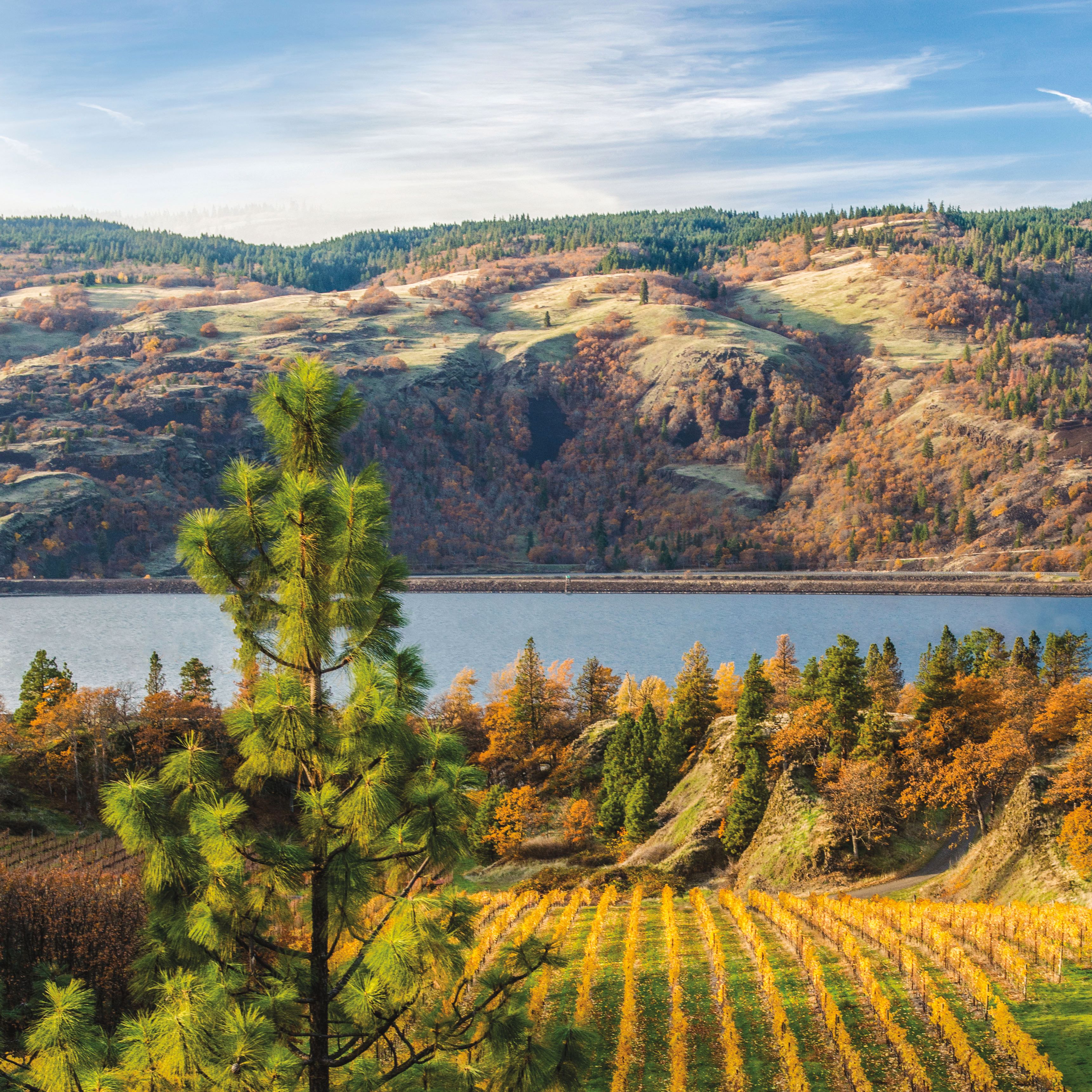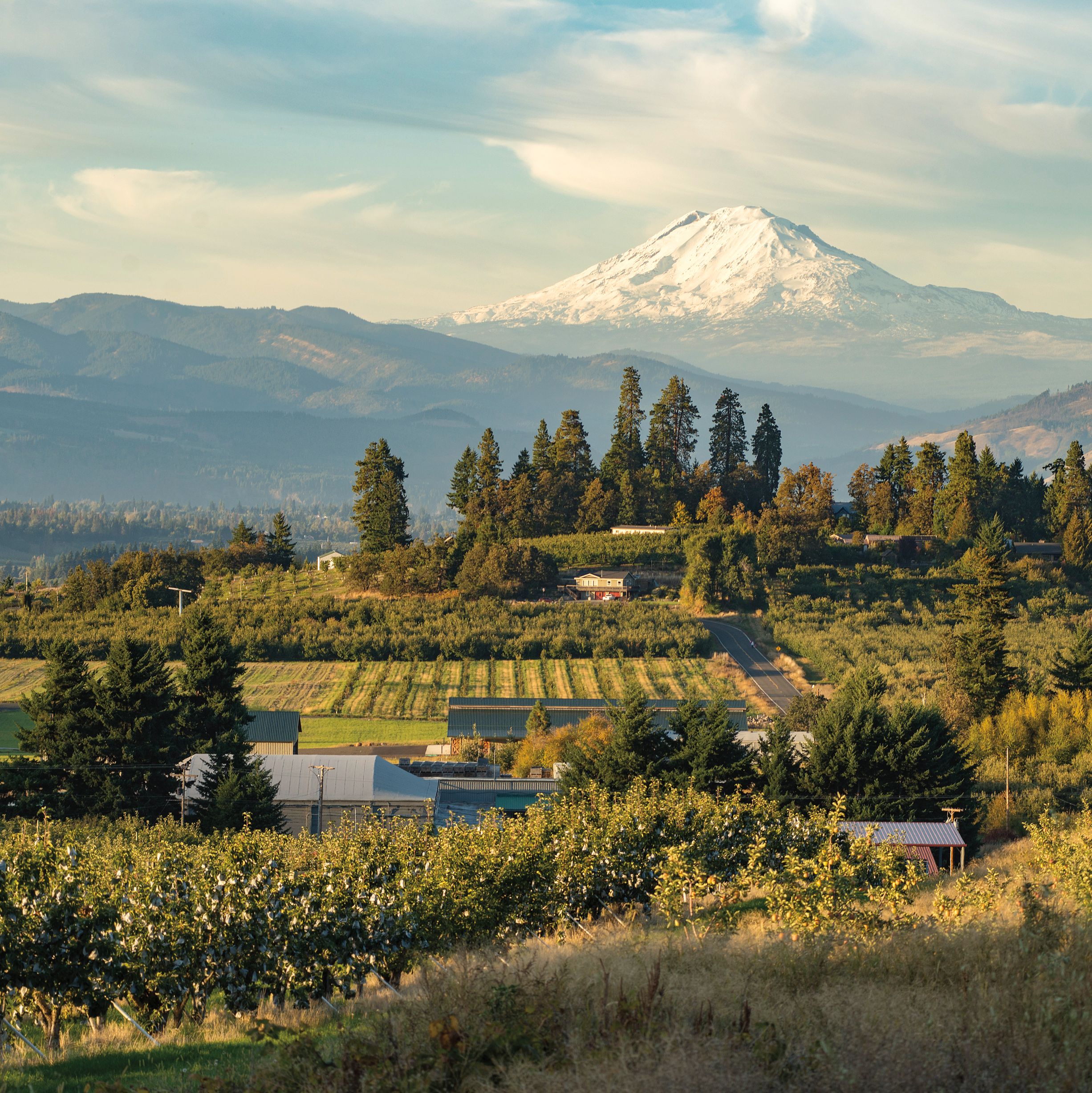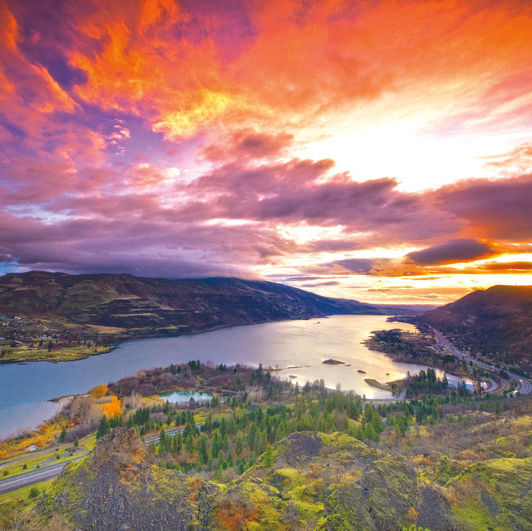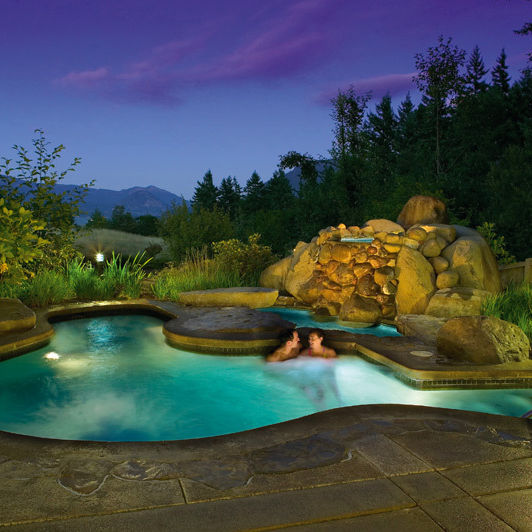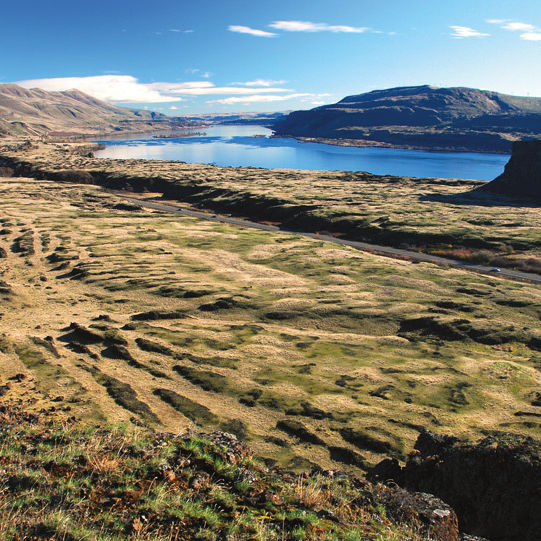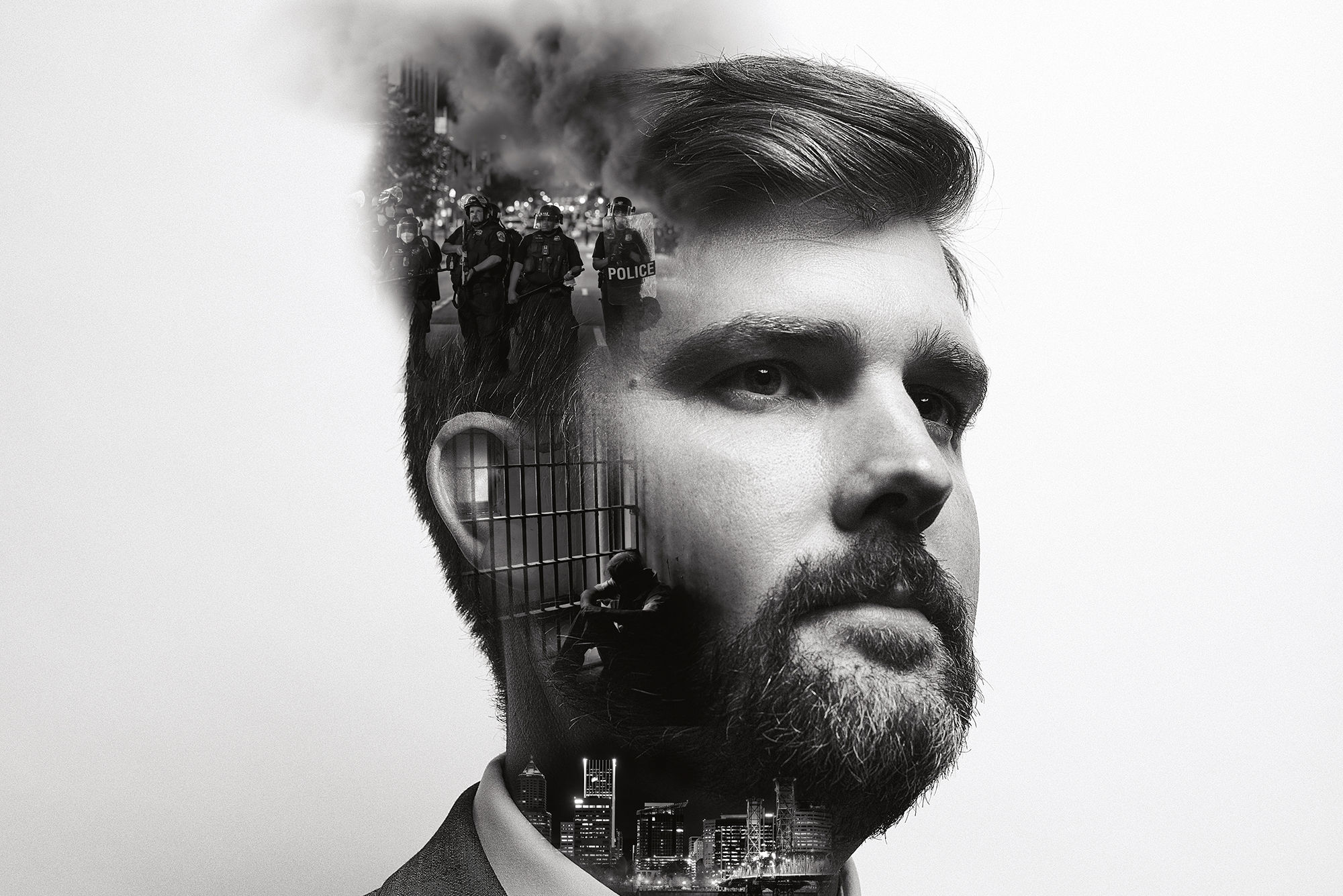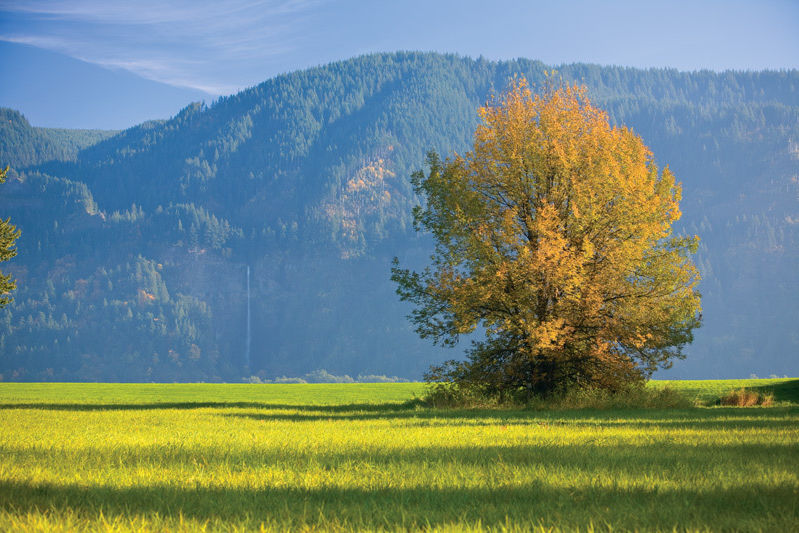
How John Yeon Shaped the Columbia River Gorge
If the six-year effort to pass the Columbia River Gorge National Scenic Area Act were a theater performance instead of a political fight, Scene 1 might have begun in August, 1979, with a picnic served atop a Ming Dynasty antique tray on a grassy berm directly across from Multnomah Falls. The time: early evening. The guests: Portland stockbroker Bruce Russell and his wife, Nancy, an outdoorswoman, Portland Garden Club member, and nature photographer. The host: John Yeon, architect, art collector, and conservationist. The setting: 75 acres of riverfront Yeon had saved from development and then shaped into a kind of nature theater he dubbed “The Shire.” The plot: woo Nancy Russell to Yeon’s lifelong fight to protect the beauty of the Gorge.
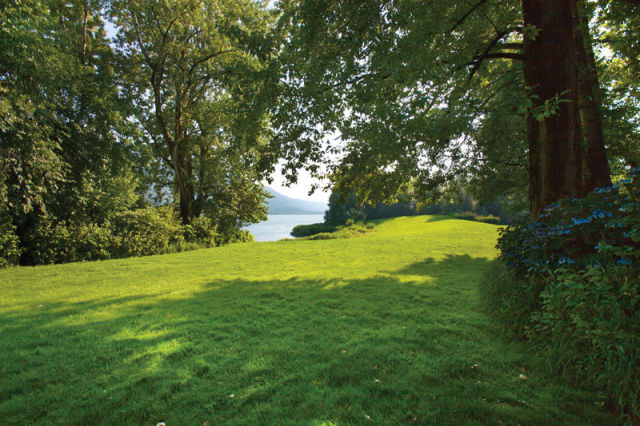
Covered in soft Astoria bent grass, an amphitheater-shaped lawn rises from one of several bays Yeon carved out of the river’s edge.
Image: Susan Seubert
As the waning sun glazed the north-facing cliffs in a dappled pink sheen and Multnomah Falls glimmered, Yeon made his case. His own conservation efforts had begun in the early 1930s when Oregon Governor Julius Meier appointed him, at age 21, to the State Park Commission. In the decades since, he had lobbied federal officials, governors, and senators and testified before Congress, with only incremental successes.
But, now the threats were turning more urgent: a new freeway connection eventually dubbed the Glenn L. Jackson Memorial Bridge was, Yeon believed, about to unleash uncontrolled exurban sprawl on the largely unprotected northern side of the river. “The Gorge,” Yeon wrote to Senator Mark Hatfield, “is an orphan which Washington has abandoned and Oregon cannot adopt.”
Hatfield had outlined to Gorge supporters what he believed was needed to pass federal legislation: a citizen effort that included prominent Democrats and Republicans from both sides of the river. Nancy Russell’s social connections, her popular slide lectures on the Gorge’s flora, and her reputation for unstoppability (most notoriously on the tennis court) signaled to Yeon a worthy ally. And on this carefully chosen night, he was courting her.
Planted with a carefully chosen Astoria bent grass soft as a fur rug, the berm the trio ate upon that night gently rose from the river’s edge into a muscular, protractor-perfect curve facing the falls like an amphitheater. For Russell, a lover of landscapes both wild and groomed, the setting had its desired effect: within the year, she would host her own picnics there with the region’s movers and shakers to gather the coalition Hatfield demanded.
The story of Russell’s cheerleading, cajoling, shoving, and ultimately driving home the 1986 Columbia River Gorge National Scenic Area Act has been well told. (See Portland Monthly’s August 2006 issue, for example.) Yeon’s place in this history is far less known. Yet his advocacy stretched over five decades and involved everything from writing the Gorge’s first environmental impact statement to fussing over the details of the concessions at Multnomah Falls. Although the federal legislation fell far short of what Yeon dreamed of, he and his idyllic riverfront reserve were guiding lights without which the 292,500 acres we know today as the Columbia River Gorge National Scenic Area might not exist. As Russell herself put it, “Somebody like John is terribly important to have in these things—a star up there in the sky, a pure point of view.”
Born in 1910, Yeon (pronounced “yawn”) grew up as economic and political forces were variously reshaping the Columbia River Gorge from wild frontier to shipping corridor, electricity generator, and industrial engine. But he believed its wild beauty should and could be both preserved and made accessible.
“I cannot possibly express my endless pleasure in the magnificence of the Gorge nor my sense of its uniqueness,” he wrote, summing up his view in an undated letter to Hatfield. “Its seried crags and collection of waterfalls exist between rain forests and semi-deserts, combining a contrast of landscapes usually separated by great distances, if not by oceans…. No other city has such a rare resource as close as a suburban park. And if it had, no other city would tolerate its imminent degradation.”
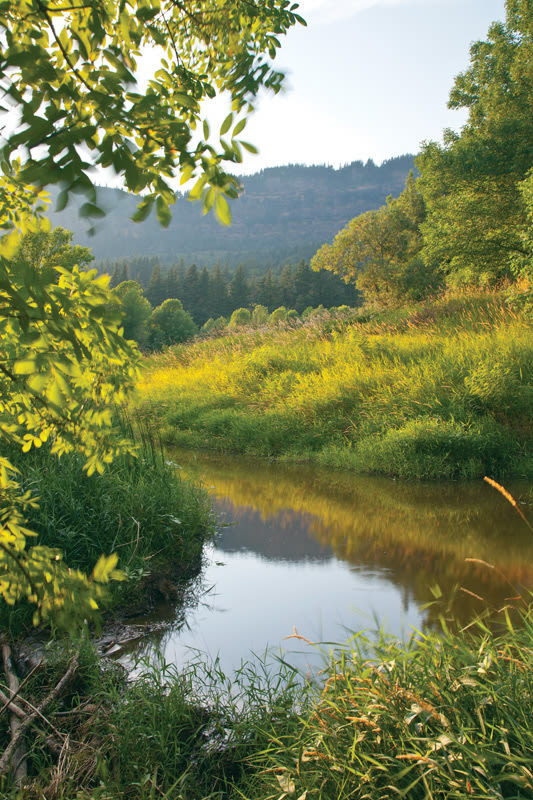
Yeon restored a creek bed on the property that’s now often dammed by beavers.
Image: Susan Seubert
Yeon’s connection ran deep. His father, John B. Yeon, made a fortune in timber, built what was then the state’s tallest high-rise (the Yeon Building at 522 SW Fifth Ave) in 1911, and then turned full-time civic volunteer as Multnomah County’s first road master. Collaborating with patrons Sam Hill and Simon Benson and engineer Samuel Lancaster, the elder Yeon, beginning in 1913, oversaw the nine-year construction of the Columbia River Highway, the first paved highway in the state. Their goal: a scenic road for tourism that, in Lancaster’s words, would “rival if not surpass anything to be found in the civilized world.”
The younger Yeon became a worthy inheritor to his father and collaborators’ legacy. Largely self-taught as an architect (he often said he got his most important education combing the library of early-century Portland architect Herman Brookman), Yeon emerged in his 20s a fully formed visionary, pioneering a Northwest brand of modernism in a series of homes and gardens that landed him among the likes as Frank Lloyd Wright, Philip Johnson, and Richard Neutra in international magazines and four exhibitions at New York’s Museum of Modern Art. For Oregon, Yeon’s conservation efforts arguably were even more far-reaching if not as widely known. In the early 1930s, he borrowed $15,000 on a life insurance policy to buy Chapman Point, north of Cannon Beach, to stop a dance hall from marring what today is one of the most photographed vistas on the coast: the view of Haystack Rock from Ecola State Park. He successfully battled the powerful state highway engineer R. H. “Sam” Baldock to stop huge chunks of Neahkahnie Mountain from being blown away for a new road. And the governor appointed him chair of both the State Park Commission (where he helped lay the groundwork for the Oregon’s park system) and the Columbia Gorge Committee, a federal-level planning effort to envision an economic development and conservation plan for the region in anticipation of the Bonneville Dam.
In 1937, Yeon penned the committee’s final report, “Conservation and Development of the Scenic and Recreational Resources of the Columbia Gorge”—in effect, the area’s first environmental impact statement. While fully embracing the economic and industrial potential of the dam, Yeon proposed that “the Gorge in itself is an industry paying substantial annual dividends as an exhibit of surpassing natural scenery … as long as its wild and magnificent scenery survives.” His report went on to outline plans for recreation facilities, trails, game refuges, and even the early notion of “beauty screens”—wide strips of trees bracketing the highway to block views of timber operations. But perhaps most important, the report successfully argued that the Bonneville Dam’s power should be sold for a flat rate within the region rather than more cheaply closer to the dam. The Portland Chamber of Commerce opposed such flat rates for fear that the dam’s inexpensive power, if made too widely available, would further power Seattle’s rise. But Yeon and his committee prevailed, thereby removing economic incentives for factories to build closer to the dam, where they would mar the Gorge’s scenery.
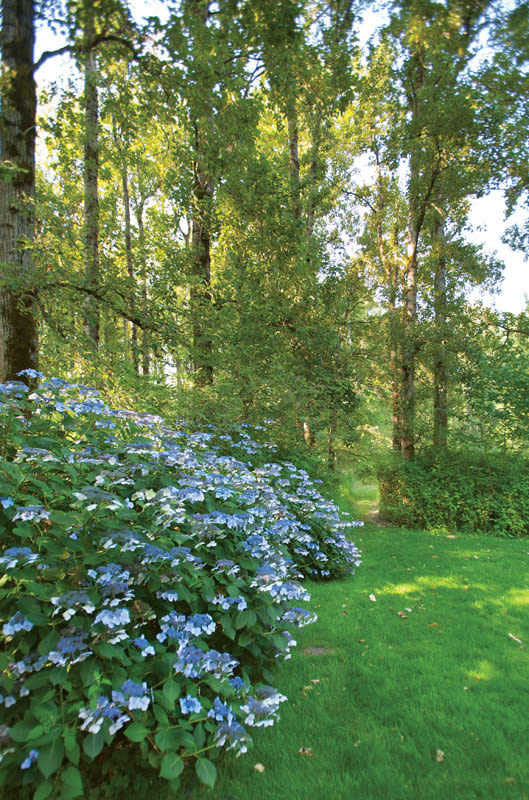
Yeon pioneered the use of native plants in Northwest garden design. But in the free-form mix of natural and human-made landscape at the Shire, he planted whimsical blue hydrangeas
Image: Susan Seubert
By his 60s, Yeon had grown frustrated with the often lurching stops, starts, and turns of architectural clients and the committee work of government. He gradually turned full time to art collecting, museum exhibition design, and behind-the-scenes advocacy. In one of Portland’s earliest efforts at historic preservation, he enlisted powerful New York Times architectural critic Ada Louise Huxtable in a successful campaign to save the carved, marble First National Bank (now Bank of the West at 401 SW Fifth Ave) from being torn down for a parking lot. Yeon lobbied the designers of what’s now Governor Tom McCall Waterfront Park to abandon plans for a scattered array of playgrounds and barbecue pits in favor of a more formal design that, in his words, would be a bold “unifying element” against the chaotic backdrop of the city. Albeit unsuccessfully, he even argued for the demolition of one of his own buildings, the 1948 Portland Visitors Information Center (now the Rose Festival Foundation headquarters), for fear its conversion into a restaurant would be “the nose of the camel under the tent” for more commercial development of Waterfront Park.
Similarly, he quietly advocated for the Gorge, most visibly in his constant pressing for better freeway design. The same kind of straight-line, blast-away-the-landscape engineering Yeon had battled at Neahkahnie grew to be a national standard that, as Highway 30 grew into I-84, Yeon fought again, personally lobbying federal transportation authorities to add the river-hugging curves we know today.
But in 1966, Yeon he combined his inventive design aesthetic and his love for the Gorge in 75 acres of land across from Multnomah Falls he bought for $50,000. With a hired bulldozer operator and no client or committee to compromise his vision, he reshaped the mile-long expanse of the shore into the Shire.
In some places, Yeon restored creek beds and wetlands. But “naturalism” was less his aim than a curated experience of pleasing views. He cleared vast expanses of blackberries, replacing them with grasses to form sweeping meadows. The site’s human-made relics—the pilings of an old railroad spur and the remnants of a 19th-century pear orchard—he turned into destinations connected by sharply mowed trails through the tall grass, like the follies in an English picturesque garden.
But it was for Multnomah Falls that Yeon devoted the most attention. There was, of course, the dramatic amphitheater directly facing the cascade, a kind of great lawn. In Yeon’s orchestration of every experience on the property, he plays the falls like a leitmotif in a symphony, in captured views throughout—in one case through a long series of keyhole cuts pruned in the trees.
Kenneth Helphand, a University of Oregon Knight professor of landscape architecture, likens the experience to great European landscape viewpoints known as belvederes. But in Yeon’s masterly effort to highlight the “the sublime” in the Gorge, Helphand argues that the Shire stands well with 1970s American land art works like Robert Smithson’s Spiral Jetty or Walter deMaria’s Lightening Field—despite predating them by several years. “If Smithson had made it,” Helphand says, “we’d be talking about the Shire as a great work of environmental art.”
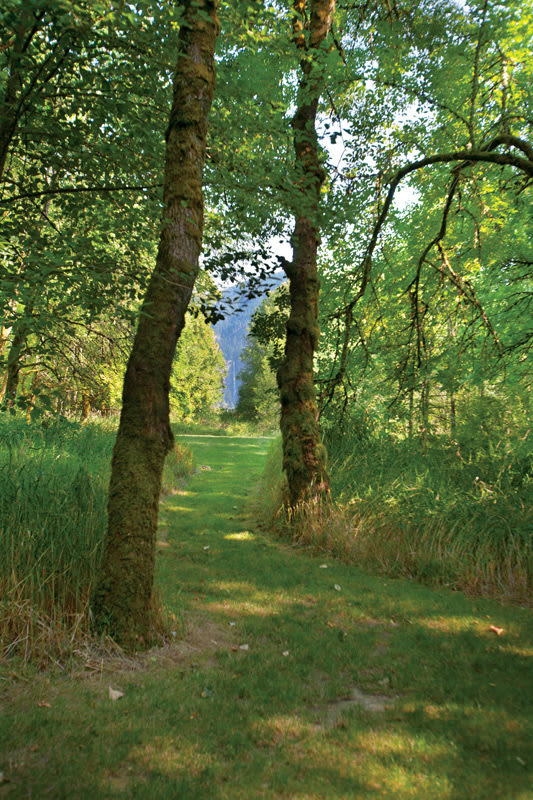
One of the Shire’s many mowed paths leads the stroller to a dead end and, upon turning around, to a captured view of Multnomah Falls through a series of carefully pruned keyhole cuts.
Image: Susan Seubert
As the I-205 bridge took shape in 1980 and Washington’s Skamania County began rezoning land on the Columbia’s north shore—in one case, right next door to the Shire—Yeon became more vexed. Since 1935, he had envisioned a federal act to preserve the Gorge but had always imagined oversight to fall under the National Park Service. A group called the Columbia River Gorge Coalition, led by a former Friends of the Earth national parks expert named Chuck Williams, had begun pushing for park service oversight. But Yeon had little confidence in grassroots efforts, and his own long-employed techniques of persuasion—personally lobbying the powerful—were also yielding few results. (He famously lost his temper at Governor Vic Atiyeh for his “do-nothing position.”) Russell, he hoped, would be a cooler, calmer, more effective advocate. And so she proved to be. The summer following her fateful dinner at the Shire, she organized her own picnic there, inviting two dozen women, most of them Portland Garden Club members, many married to powerful doctors, bankers, and members of the media, and all well-connected socially and politically. Russell’s sister, Betsy Smith, who attended the picnic, still recalls the scene: the Laura Ashley skirts and Bermuda shorts, the swims to a nearby island, the potluck of chicken sandwiches, fruit salads, deviled eggs, and fresh strawberry pies served on card tables covered in checkered cloths.
“It’s such a romantic place,” Smith laughs, “like stepping out of an Edwardian novel.”
Yet beneath the Old Portland sense of refinement was the muscle that made the picnic, as Russell later recalled, “a milestone” in her early efforts. Soon that group added to its numbers and clout, growing into the Committee to Save the Columbia River Gorge and then the Friends of the Columbia Gorge. But as forceful and well-connected as she could be, Russell was ultimately a political pragmatist. With two states, six counties, and more than a dozen communities ruling their own roosts in the Gorge, park service oversight, she believed, was a political impossibility. Thus, the Friends came to help engineer the 1986 act, placing the federal “scenic area” signs at the entrances to the Gorge, making the US Forest Service the manager of the 127 square miles in between but leaving the policy-making to the Columbia River Gorge Commission—all local.
To Yeon, though, anything short of park service oversight was an effort “to save the Gorge by wishful thinking and hot air,” he wrote in a wrenching letter to Russell critiquing the Friends’ approach. “The danger is not only that nothing can be done that way, but that the public will perceive that … the danger has been averted.”
“My silence has been sensible,” he said of his unwillingness to support the Friends, “because I am not persuasive and have no constituency.”
After 26 years, the Gorge scenic area act, like any complicated legislation, has engendered mixed results, leaving the Gorge spotted by more development than advocates had hoped but more pristine than it could have ever been without protection.
Yeon’s disappointment may be best summed up by one of his final efforts to safeguard the Gorge’s beauty. In 1989, five years before his death, he joined the citizens’ advisory committee overseeing a new master plan for Multnomah Falls. A young Mike Abbaté, then the US Forest Service’s landscape architect in charge of the project (now Portland Parks and Recreation’s director), recalls how, over 18 months of meetings, Yeon strenuously pushed to remove numerous concessions around the falls and the lodge (designed by an early Yeon employer, A. E. Doyle). Then, even with the final master plan camouflaging the snack bar and store into a barely noticeable addition carved into the hillside, well out of the most prominent sight lines of the lodge and falls, Yeon still resigned in protest.
“When I go there today and see the coffee cart,” Abbaté says, laughing, “I think of John and how it would bug him that it’s there.”
During his summer-evening recruitment of Russell, Yeon made certain no such compromises stood in the view. Indeed, after he first scheduled their dinner, Russell recalled how Yeon abruptly rescheduled it at the last minute—twice. Mystified and a little annoyed, she and her husband actually were surprised when a date finally stuck. But as their evening of conversation and persuasion unfolded and the sun set, she finally understood the delays as Yeon delivered what would become the evening’s most powerful argument: a full moon rising in the eastern cleft of the Gorge. In a perfect summation of the man and his vision, Yeon had been waiting for the perfect weather.
